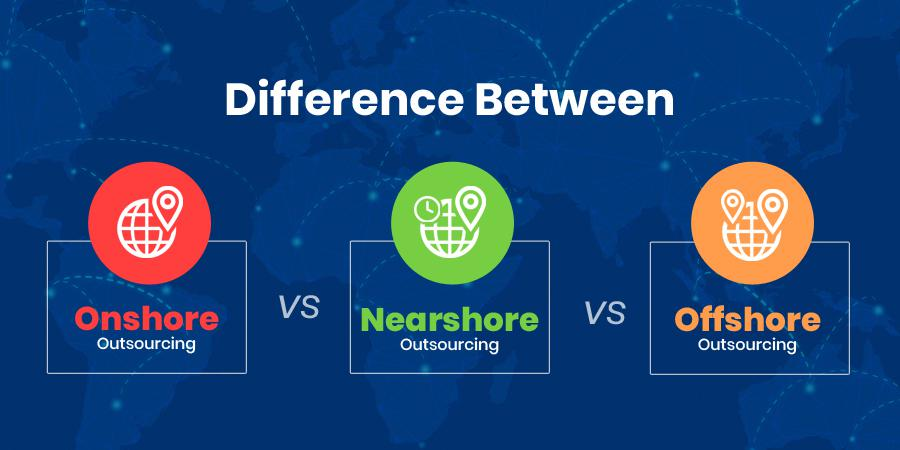The debate between Onshore, Offshore, and Nearshore models has been a top discussion in the IT industry, particularly when it comes to software and mobile app development services. The IT industry has managed the advantages of outsourcing to extend the boundaries of software development projects. According to an article from Capital Counselor, the United States outsources approximately 300,000 jobs each year, making it a significant contributor to the growth of the outsourcing industry. Based on a market report by Mordor Intelligence, the IT outsourcing market’s value was $526 billion in 2021, and it is projected to reach $682 billion by 2027, with a Compound Annual Growth Rate (CAGR) of 4.13% between 2022 and 2027. Projects like mobile app development can be expensive and often operate under tight budgets. Outsourcing to agencies that offer flexibility in project development costs can be a beneficial strategy in such situations. However, it can also raise complexity when deciding between onshore, offshore, and nearshore models. To make an informed decision, it’s essential to have a good understanding of these models and how various factors influence the choice of the most suitable one.

What is Outsourcing?
Outsourcing is an agreement in which one company engages or hires another company to assume responsibility for a specific planned or ongoing activity that might otherwise be conducted internally, i.e. in-house. This arrangement may also include the transfer of employees and assets from one company to another.

What is Onshore Outsourcing?
Onshore outsourcing, often referred to as domestic outsourcing, involves engaging service providers from the same country but outside of the in-house team. For instance, when a US-based organization hires a software development outsourcing company located within the United States, it is considered onshore outsourcing. This approach offers several well-known advantages, including no language barriers, familiar culture, similar time zones, and adherence to local laws and regulations. For example, copyright and IP laws are enforced better in the US than in most countries and a US-based company can protect its interests with onshore outsourcing due to such strong laws.
However, it’s important to note that onshore outsourcing has gained a global reputation for being relatively more expensive when compared to other outsourcing alternatives.
What is Nearshore Outsourcing?
In the IT industry, nearshore outsourcing involves the practice of hiring software and app development services from neighboring countries with similar time zones, cultures, and native languages. For example, if a company based in the United States outsources its software and app development tasks to a service provider located in Canada, this can be considered as nearshore outsourcing. It is somewhat similar to onshore outsourcing but some aspects like laws/regulations and travel distance may be different.
What is Offshore Outsourcing?
In the world of the IT industry, offshore outsourcing is the practice of hiring the services of app and web development companies situated in distant countries with different time zones, languages, and cultures compared to one’s own. It may involve both remote collaboration and on-site services from the service provider, typically located on a different continent from the client company.
For instance, when a U.S.-based company outsources its software and app development projects to agencies based in countries such as India, China, or Ukraine, it falls under offshore outsourcing. The advantages of this approach include cost-effectiveness and rewarding outcomes. Sometimes, it also comes with disadvantages, like distinct laws & regulations, managing time zone differences, language and cultural barriers, and miscommunication.
Why do companies Outsource Software Development Services?
Initially, the motivations behind outsourcing software development might appear straightforward: a need for software leads to the engagement of experts to build it. Let’s explore additional advantages that are driving companies to embrace the practice of outsourcing.
I. Cost Savings
One of the biggest reasons for outsourcing is cost savings. Outsourcing can significantly reduce labor and operational costs. Businesses can save a lot on their operating costs and execute the project without any budget overruns. And there are several ways it can help you save big money.
Rather, you can hire a dedicated development team and choose to outsource some portions of the development process to them. This will ensure quality as well as cost savings.
II. Focus on Core Competencies
By outsourcing non-core software development tasks, companies can concentrate on their core business activities, such as product development, marketing, and customer service, without getting bogged down in technical details.
III. Gain Access to a Larger Pool of Talent
Outsourcing allows companies to tap into a diverse range of skilled developers and specialists worldwide. This access to a broader talent pool often results in higher-quality work and innovation. Outsourcing software development eliminates geographical gaps, granting you access to a world of top-tier talent.
IV. Achieving Easy Scalability
Companies can easily scale their development teams up or down as project requirements change, providing flexibility and cost efficiency, especially for fluctuating workloads.
V. Faster Time-to-Market
Being the first to market with your product can deliver an enduring competitive edge. Outsourcing enables faster development cycles as development agencies or teams are experienced and often work on similar projects. This can help companies bring their products or solutions to market more quickly. Time equals money, and outsourcing your software development can serve as a solution to manage delays and meet critical delivery deadlines.
VI. Specialized Expertise
Outsourcing to experts in specific technologies or domains allows companies to benefit from specialized knowledge and experience, which may not be readily available in-house.
VII. Risk Mitigation
Outsourcing can help distribute project and operational risks. By working with established outsourcing partners, companies can share accountability and mitigate potential challenges.
VIII. Increased Productivity
Outsourcing can boost productivity by leveraging the efficiencies and best practices of experienced development teams. This can result in higher-quality software delivered on time.
IX. Focus on Innovation
Companies can free up resources for research and innovation by delegating routine software development tasks to external experts.
X. Geographic Expansion
Outsourcing allows companies to establish a global presence and extend their operations into different markets without the need for a physical presence in each location.
XI. Cost Predictability
Fixed pricing models and well-defined contracts with outsourcing partners can provide cost predictability and control.
XII. 24/7 Operations
By partnering with teams in different time zones, companies can maintain 24/7 operations, ensuring that development work progresses even when their in-house team is offline.
XIII. Enhanced Security
Reputable outsourcing providers often have robust security protocols and compliance measures in place to protect sensitive data, ensuring a high level of security for the project.
In summary, companies outsource software development to optimize costs, access global talent, improve efficiency, and leverage specialized expertise, all of which contribute to achieving their business goals more effectively and competitively.

Difference between Onshore, Offshore & Nearshore Outsourcing
The difference between these various outsourcing types has a direct impact on the final product of your software, app, or website development needs. It’s important to evaluate them carefully in order to select the most appropriate approach for your specific project.

Onshore vs Offshore vs Nearshore
| Characteristics | Onshore | Offshore | Nearshore |
| Project Cost | High | Cost-effective | Somewhat High or Fair |
| Location | Same Country | Different Continent Country | Nearby/Neighbor Country |
| Time Zones | Same | Completely Different | Same or Minor differences |
| Native Language | Same/Familiar | Different | Same or Familiar |
| Culture | Same | Completely Different | Same, Familiar, or Somewhat Different |
| Laws & Regulations | Same | Completely Different | Same, Similar, or Different |
| Confidential Information Safety | High | Low or High | High or Low |
| Collaboration | Easy | Somewhat Easy or Difficult | Easy or Difficult |
| Communication | Clear | Miscommunication Possible | Clear or Miscommunication Possible |
| Monitoring Project Development | Easy | Not Easy | Easy |
Here is a detailed description of how various factors can impact onshore, offshore, and nearshore IT outsourcing:
I. Project Costs
Onshore: The project costs associated with onshore projects are typically high, particularly in countries such as the US and UK.
Offshore: Engaging development services from distant countries is known for its cost-effectiveness and profitability. This is why US-based companies often choose offshore software developers from countries like India and Ukraine.
Nearshore: The project cost may reach onshore levels, depending on the specific development agencies you select.
II. Location
Onshore: In an onshore outsourcing arrangement, you engage a development agency that operates within your own country.
Offshore: Offshore outsourcing entails hiring a development agency from a distant country, often on a different continent.
Nearshore: Nearshore outsourcing involves partnering with a development agency located in a nearby or neighboring country.
III. Time Zones
Onshore: In onshore outsourcing, the time zone and working hours of the development agency align with those of the client. They share the same time zone and work during similar hours.
Offshore: Offshore outsourcing involves hiring a development agency from a country with a time zone difference. For instance, a US-based company outsourcing software development to India or Ukraine may face different time zones. To manage this, the developer can either adapt the working hours to align with the client’s time zone or choose mutually convenient working hours.
Nearshore: In nearshore outsourcing, the time zones are either the same as the client’s or have minor differences.
IV. Native Language
Onshore: In onshore outsourcing, the developers’ native language is the same as the client’s. Communication is easy by sharing a common native language.
Offshore: Offshore outsourcing often involves developers whose native language is different from the client’s. However, effective communication is generally maintained as English is the international language.
Nearshore: In nearshore outsourcing, the native language of the developers is either the same as the client’s or familiars, making communication smoother.
V. Culture
Onshore: In onshore outsourcing, the culture of the hired agency is either the same as the client’s or familiar.
Offshore: Offshore outsourcing often involves a hired agency with a culture that is entirely different from the client’s.
Nearshore: In nearshore outsourcing, the culture of the hired agency may be the same, similar, or somewhat different from that of the client.
VI. Laws & Regulations
Onshore: In onshore outsourcing, the laws and regulations of the development agency are similar to those of your company. This allows you to safeguard your company’s interests and comply with local regulations.
Offshore: Offshore outsourcing often involves developers who operate under laws and regulations that are completely different from your own. However, a reputable app development company should possess the knowledge and expertise to navigate the legal landscape of the location where your app will be operating.
Nearshore: In nearshore outsourcing, the laws and regulations are either the same or similar to those of your company.
VII. Confidential Information Safety
Onshore: In onshore outsourcing, the risk of confidential information leaks, such as client data, target audience details, or company documents can be prevented.
Offshore: In offshore outsourcing, the potential for leaks of sensitive information is a concern, but it can be avoided by working with a reputable and trustworthy agency.
Nearshore: When it comes to nearshore outsourcing, the security of confidential information can be effectively managed with proper management and precautions.
VIII. Collaboration
Onshore: In onshore outsourcing, the option for frequent in-person meetings and visits is readily available, ensuring effective collaboration. This face-to-face interaction often leads to a more satisfactory final product.
Offshore: Collaboration in offshore outsourcing can vary in ease, depending on how both parties manage the process. It may involve some challenges, but with effective management, it can also be straightforward.
Nearshore: In nearshore outsourcing, collaboration can be easy or difficult, depending on various factors. It falls between onshore and offshore in terms of collaboration convenience.
IX. Communication
Onshore: In onshore outsourcing, the chances of miscommunication are minimal.
Offshore: Miscommunication can be a challenge in offshore outsourcing, but it can be reduced through effective management and execution.
Nearshore: The probability of miscommunication in nearshore outsourcing is generally low, although there is a possibility of it occurring in some areas.
X. Monitoring Project Development
Onshore: Monitoring the project development process and the work ethic of developers is easy in onshore outsourcing.
Offshore: Offshore outsourcing can be difficult to effectively monitor the development process, which may impact the quality of the final product.
Nearshore: Nearshore outsourcing facilitates the management and monitoring of the development process, making it convenient to achieve a successful outcome.
Factors to consider when outsourcing Software Development Team
Let’s take a look at some of the factors to consider for making outsourcing decisions for your business.
I. Project Requirements: Clearly define your project’s objectives, scope, and specifications. Have a detailed understanding of what you want to achieve and the features you require.
II. Budget: Determine your budget constraints and allocate resources accordingly. Understand the cost structure, payment terms, and any potential additional expenses.
III. Quality and Expertise: Assess the expertise and qualifications of the outsourcing partner. Review their portfolio, check their industry experience, and verify their technical skills.
IV. Communication: Establish effective communication channels and protocols. Ensure that you and the outsourcing team can communicate clearly and promptly, despite potential time zone differences.
V. Geographical Location: Decide whether you want an onshore, nearshore, or offshore outsourcing partner based on your specific needs, considering factors such as cost, time zone, and cultural alignment.
VI. Security and Data Privacy: Discuss and implement security measures to protect sensitive data. Ensure that the outsourcing partner follows security standards and compliance requirements.
VII. Scalability: Consider the flexibility of the outsourcing partner to scale up or down as your project evolves. Ensure they can accommodate changes in requirements and workloads.
VIII. Contract and Legal Aspects: Define the terms and conditions of the contract, including project milestones, delivery schedules, intellectual property rights, and dispute resolution mechanisms.
IX. References and Reputation: Check the outsourcing partner’s reputation in the industry. Request client references and read reviews to gauge their reliability and past performance.
X. Cultural Compatibility: Understand and respect cultural differences and norms that may affect the working relationship and communication style.
XI. Technology Stack: Confirm that the outsourcing partner is proficient in the technologies and tools you intend to use for your project.
XII. Data Backup and Recovery: Discuss data backup and recovery procedures to safeguard against potential data loss or disruptions.
By considering these factors and addressing them during the outsourcing process, you can make informed decisions and mitigate potential risks, ultimately leading to a successful outsourcing partnership and software development project.
Recommendation Section: How to Hire a Dedicated Software Development Team?
Wrapping Up
Overall, outsourcing offers tremendous advantages to most companies, driven by cost savings and improved quality. However, fulfilling the full benefits of outsourcing depends on selecting the right service provider as your partner.
To help you with this process, you can explore our guide on selecting an outsourced team effectively or you can collaborate with us “Ailoitte”. We firmly believe that our skills, experience, and track record of successful apps make us the ideal match for your project.
If you are still unsure about whether outsourcing is a suitable choice for your needs, Reach out to us and our experts will assist you in reaching a well-informed decision.
Frequently Asked Questions
Nearshore outsourcing is hiring service providers from nearby or neighboring countries. Offshore outsourcing is hiring service providers from faraway countries.
Onshore outsourcing is the best choice for those needing service providers that have the same nationality and culture. On the other hand, offshore outsourcing is the best choice for those that require cost-effective and experienced service providers.
A lot of companies often choose to outsource to India because of the wide talent pool. The Indian workforce consists of skilled professionals who are well-versed in world-class business practices. They can accomplish various tasks efficiently and deliver quality work.
Nearshore outsourcing is hiring service providers from nearby or neighboring countries. Onshore outsourcing is hiring a service provider from the same country as yours.
Once you’ve established the IT outsourcing model and type that aligns with your requirements, the next step is to identify the ideal outsourcing partner. To make this selection, consider the following steps:
1. Check the company’s portfolio and assess its approach to app development.
2. Compare the estimates they provide for your app implementation.
3. Look through their reviews and ask them for references.
4. Analyze their ratings on directory websites, such as Clutch, Good Firms, G2, Top Developers, etc.
5. To protect your project idea, sign a Non-Disclosure Agreement (NDA) with the outsourcing partner.
Onshore is great if developers from the same country with a similar culture/language are an option you prefer.
Choose nearshore if developers from nearby or neighboring countries are a beneficial option for your requirements. Choose offshore if you need cost-effective services that guarantee top-of-the-line results as well.


















.png)
.png)
.png)



Thank you for your sharing. I am worried that I lack creative ideas. It is your article that makes me full of hope. Thank you. But, I have a question, can you help me?